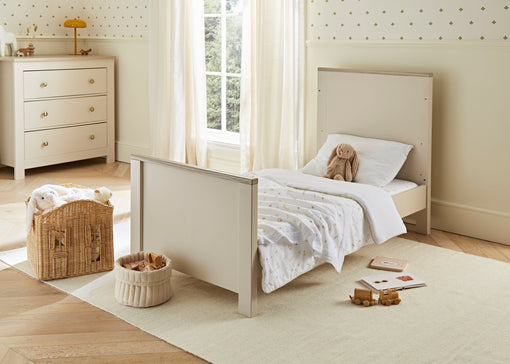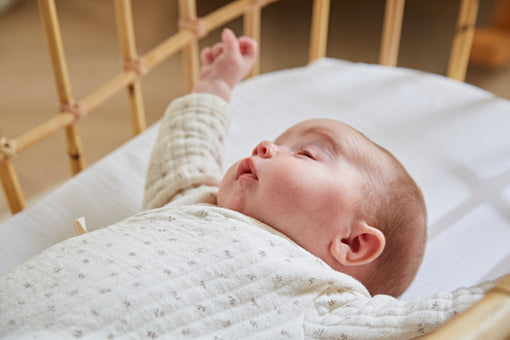With your baby on the way, you’ll want to learn how to set up a baby changing station.
You basically only need 2 things: storage space and a flat surface, but what about something more stylish to organise your nursery essentials?
A nursery dresser with a baby changing station on the top is great for staying organised. It provides lots of storage space to keep nappies, baby wipes and other essentials at your fingertips.
You’ll want to make your baby changing station or nursery dresser as organised as possible so that it’s easy and handy to use.
If you don’t have much room in your nursery, the space-saving Torsten changing top is a compact solution. It is designed to quickly fit onto the matching Torsten Cot, so you can easily and comfortably change your baby’s nappy.
If you are lucky enough to have room for a nursery dresser, we highly recommend getting one. Read on to discover tips for practicality and a list of items you need to keep on hand for convenience.
4 tips for setting up a changing station in your nursery
-
Choose A Baby Changing Table Dresser With Large Drawers

Having large drawers underneath the baby changing table, means you’ll always have your essentials at hand. You’ll be surprised how much storage space you’ll need to keep your nursery tidy. The average baby goes through 8 to 10 nappies a day, so you’ll need somewhere to put them.
The most practical nursery dressers have a removable baby changing top, so the changer converts into a set of drawers. Read how to choose a baby changing table to learn about safety features and why you should look out for toxic paints.
The best place for the changing station will be in your baby’s bedroom. After all, you’ll be spending a lot of time there and you’ll need to change your little one’s nappy at naptime, bathtime and first thing in the morning.
-
Comfy Changing Mats Reduce Stress For You And Your Baby

Changing mats with raised sides prevent your baby from rolling, making it easier to change their nappy. They are made from soft memory foam that is supportive, but it also makes your baby more comfortable and happier when being changed. Bamboo foam changing mats are luxuriously soft against your baby’s skin and they have a removable cover that is machine washable too.
-
Keep A Nappy Bin Close To The Nursery Dresser
Nappy pail or an odour-sealing bin will mean that you can quickly dispose of dirty nappies. This means you don’t have to leave your baby to go and dispose of the nappy. A bin with a foot pedal will keep your hands free. It also means you don’t have to bend down as much.
Although you’ll still need to empty the nappy bin into your dustbin to prevent it from smelling, most parents still consider a nappy bin essential. It’s more convenient to go to the dustbin once a day, rather than 10 times a day. Especially if the weather is bad.
-
Keep These Baby Changing Essentials Within Easy Reach
Nappies
Take nappies out of their plastic packaging and put them into the top drawer of your nursery dresser. Then they will be quicker to grab when your baby is wriggling around.

Baby Wipes
Like nappies, you’ll need to stock up on baby wipes and put some in the top drawer of your dresser, so they are at your fingertips. Always have plenty of baby wipes at the changing table, in your car, in the pram and other places where you’ll have baby with you.
Baby Wipe Hack:
If you buy a flat pack of wipes, it can be hard to remove just one wipe at a time. The trick is, once you’ve taken the sealed tab off your baby wipes, cut a slit on each side to extend the opening all the way. This makes it easier to grab one baby wipe at a time, rather than accidently pulling a chunk of them out.
Hand Sanitizer
It’s not safe to keep baby on the table while you go to wash your hands. Use hand sanitizer until your baby is safely in their bouncer or playpen, and then you can wash your hands. Remember to keep the hand sanitizer in your top drawer away from baby’s reach.
Baby Creams And Balms
Baby cream and balms should be kept on your nursery dresser. Antiseptic skin balm such as Sudocrem acts as a barrier cream when your baby has nappy rash and it soothes eczema. You could keep these on a nursery shelf near your dresser in a canvas baby essentials bag, or you could put them in a drawer.
Create a changing bag to have everything you have at home, but on the go… just make sure you have plenty of spares 😉
Other Essentials To Store In Your Nursery Dresser
There are other essentials that you’ll need to keep in your dresser and changer. These can be stored in one of the lower drawers.
Baby Nail Clippers
Keeping baby’s nails trim helps to ensure they don’t scratch themselves. An emery board can be used to smooth out rough edges too. Doctors recommend only using an emery board in the first few weeks because a newborn baby has very soft nails.
Dummies
Pacifiers always come in handy. You can store them in steriliser pots or with their caps on.

Baby’s Clothes
Grouping clothes into categories can make it easier to access your little one’s outfits. Drawer inserts and labels will make clothes easier to find. Alternatively, you can see everything at once if you fold the clothes upright rather than putting them into piles.
Small items of clothing can be difficult to keep neat and tidy. The Konmari method of folding creates more space. Watch this video for tips on how to fold baby clothes neatly:
Consider A Nursery Shelf By Your Baby Changing Table
A nursery shelf with pegs will allow you to hang your baby’s outfits out. This makes changing baby quicker in a morning.

Consider A Wardrobe For Extra Storage

If you need more storage space, you could hang your babies clothes in a nursery wardrobe. The most practical designs maximise the storage potential of the wardrobe. So look for wardrobes with a deep base drawer and a shelf at the top of the wardrobe, as well as dual hanging rails.
The Clara wardrobe converts into a full-length wardrobe by removing the extra clothing rails. You can use Augmented Reality (AR) technology to see what it will look like in your room by visiting the Clara wardrobe page.





